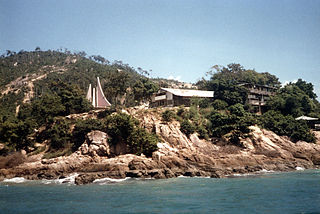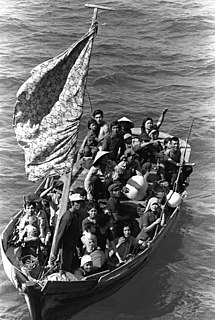Vietnamese Americans are Americans of Vietnamese descent. They make up about half of all overseas Vietnamese and are the fourth-largest Asian American ethnic group after Chinese Americans, Filipino Americans, and Indian Americans, and have developed distinctive characteristics in the United States.
The Comprehensive Plan of Action (CPA) is a program, adopted in June, 1989 at a conference in Geneva held by The Steering Committee of the International Conference on Indo-Chinese Refugees, which was designed to deter and to stop the continuing influx of Indochinese boat people and to cope with an increasing reluctance by third countries to maintain resettlement opportunities for every Vietnamese or Laotian exile, with the threat of countries of first asylum in Southeast Asia to push back asylum seekers.
Vietnamese Australians are Australians of Vietnamese ancestry, or people who migrated to Australia from Vietnam. Communities of overseas Vietnamese are referred to as Việt Kiều or người Việt hải ngoại.
Many of the Vietnamese people in Hong Kong immigrated as a result of the Vietnam War and persecution since the mid-1970s.
The American Homecoming Act or Amerasian Homecoming Act, was an Act of Congress giving preferential immigration status to children in Vietnam born of U.S. fathers. The American Homecoming Act was written in 1987, passed in 1988, and implemented in 1989. The act increased Vietnamese Amerasian immigration to the U.S. because it allowed applicants to establish mixed race identity by appearance alone. Additionally, the American Homecoming Act allowed the Amerasian children and their immediate relatives to receive refugee benefits. About 23,000 Amerasians and 67,000 of their relatives entered the United States under this act. While the American Homecoming Act was the most successful program in moving Vietnamese Amerasian children to the United States, the act was not the first attempt by the U.S. government. Additionally the act experienced flaws and controversies over the refugees it did and did not include since the act only allowed Vietnamese Amerasian children, as opposed to other South East Asian nations in which the United States also had forces in the war.

The Skyluck was a 3,500-ton Panamanian-registered freighter that carried a cargo of 2,700 Chinese and Vietnamese boat people fleeing Vietnam four years after the fall of Saigon. The ship entered Hong Kong harbour under the cover of darkness on 8 February 1979, but was discovered and ordered to set anchor by the Hong Kong Police. Thus, began a 4 1⁄2 month-long stalemate as the refugees waited on the ship for the Hong Kong government to decide their fate. The event turned into an international humanitarian incident, which was a symbol of a much larger problem: the estimated one million refugees who risked everything to flee Laos, Cambodia, and Vietnam in the aftermath of the Vietnam War.

The Bidong Island is one square kilometre in area and is situated off the coast of Terengganu, Malaysia in the South China Sea. Bidong Island is accessible from the coastal town of Merang in Setiu district.

The United States recognizes the right of asylum for individuals as specified by international and federal law. A specified number of legally defined refugees who either apply for asylum from inside the U.S. or apply for refugee status from outside the U.S., are admitted annually. Refugees compose about one-tenth of the total annual immigration to the United States, though some large refugee populations are very prominent. Since World War II, more refugees have found homes in the U.S. than any other nation [??source]and more than two million refugees have arrived in the U.S. since 1980. In the years 2005 through 2007, the number of asylum seekers accepted into the U.S. was about 40,000 per year. This compared with about 30,000 per year in the UK and 25,000 in Canada. The U.S. accounted for about 10% of all asylum-seeker acceptances in the OECD countries in 1998-2007. The United States is by far the most populous OECD country and receives fewer than the average number of refugees per capita: In 2010-14 it ranked 28 of 43 industrialized countries reviewed by UNHCR.

The International Catholic Migration Commission (ICMC) is an international organization that serves and protects uprooted people, including migrants, refugees, and internally displaced people, regardless of faith, race, ethnicity or nationality. With staff and programs in over 40 countries, ICMC advocates for sustainable solutions and rights-based policies directly and through a worldwide network of 132 member organizations.
Operation New Life was the care and processing on Guam of Vietnamese refugees evacuated from Saigon in the closing days of the Vietnam War. More than 111,000 of the evacuated 130,000 Vietnamese refugees were transported to Guam where they were housed in tent cities for a few weeks while being processed for resettlement. The great majority of the refugees were resettled in the United States. A few thousand were resettled in other countries or chose to return to Vietnam on the vessel Tuong Tin.

The Indochina Migration and Refugee Assistance Act, passed on May 23, 1975, under President Gerald Ford, was a response to the Fall of Saigon and the end of the Vietnam War. Under this act, approximately 130,000 refugees from South Vietnam, Laos and Cambodia were allowed to enter the United States under a special status, and the act allotted for special relocation aid and financial assistance.
Boat People SOS (BPSOS) is a 501(c)3 nonprofit organization devoted to Vietnamese-American civic and political activism. It is headquartered in Falls Church, Virginia. BPSOS' mission is to "empower, organize, and equip Vietnamese individuals and communities in their pursuit of liberty and dignity." BPSOS claims that one in 10 Vietnamese Americans has received assistance from BPSOS while still in Vietnam, on the high seas, in a refugee camp, or after arriving in the United States. Through their 17 office locations in the U.S. and two office locations in Southeast Asia, they provide a web of services to support individuals, families, and communities.
Sudanese refugees are persons originating from the country of Sudan, but seeking refuge outside the borders of their native country. In recent history, Sudan has been the stage for prolonged conflicts and civil wars, as well as environmental changes, namely desertification. These forces have resulted not only in violence and famine, but also the forced migration of large numbers of the Sudanese population, both inside and outside the country's borders. Given the expansive geographic territory of Sudan, and the regional and ethnic tensions and conflicts, much of the forced migration in Sudan has been internal. Yet, these populations are not immune from similar issues that typically accompany refugeedom, including economic hardship and providing themselves and their families with sustenance and basic needs. With the creation of a South Sudanese state, questions surrounding southern Sudanese IDPs may become questions of South Sudanese refugees.

The Indochina refugee crisis was the large outflow of people from the former French colonies of Indochina, comprising the countries of Vietnam, Cambodia, and Laos, after communist governments were established in 1975. Over the next 25 years and out of a total Indochinese population in 1975 of 56 million, more than 3 million people would undertake the dangerous journey to become refugees in other countries of Southeast Asia, Hong Kong, or China. Hundreds of thousands may have died in their attempt to flee. More than 2.5 million Indochinese were resettled, mostly in North America, Australia, and Europe. Five hundred thousand were repatriated, either voluntarily or involuntarily.
The Cambodian humanitarian crisis from 1969 to 1993 consisted of a series of related events which resulted in the death, displacement, or resettlement abroad of millions of Cambodians.
Refugee crisis can refer to movements of large groups of displaced people, who could be either internally displaced persons, forced displaced people, refugees or other migrants. It can also refer to incidents in the country of origin or departure, to large problems whilst on the move or even after arrival in a safe country that involve large groups of displaced persons, asylum seekers or refugees. According to the UN High Commissioner for Refugees, in 2017, 65.6 million people were forcibly displaced worldwide because of persecution, conflict, violence, or human rights violations alone.
Ban Vinai Refugee Camp, officially the Ban Vinai Holding Center, was a refugee camp in Thailand from 1975 until 1992. Ban Vinai primarily housed highland people, especially Hmong, who fled communist rule in Laos. Ban Vinai had a maximum population of about 45,000 Hmong and other highland people. Many of the highland Lao were resettled in the United States and other countries. Many others lived in the camp for years which came to resemble a crowded and large Hmong village. The Royal Thai Government closed the camp in 1992, forced some of the inhabitants to return to Laos and removed the rest of them to other refugee camps.
Third country resettlement or refugee resettlement is, according to the UNHCR, one of three durable solutions for refugees who fled their home country. Resettled refugees may also be referred to as quota or contingent refugees, as countries only take a certain number of refugees each year. In 2016 there were 65.6 million forcibly displaced people worldwide and around 190,000 of them were resettled into a third country.








